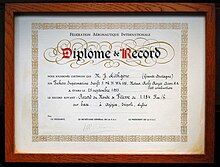|
Mike Lithgow
Michael John Lithgow, OBE (30 August 1920 – 22 October 1963) was a British aviator and chief test pilot for Vickers Supermarine who became the holder of the World Absolute Air Speed Record in 1953 flying a Supermarine Swift. He died when the prototype BAC One-Eleven airliner crashed in 1963. Early lifeMike Lithgow was born on 30 August 1920 and educated at Cheltenham College. Second World WarLithgow was a member of the Fleet Air Arm from March 1939 – December 1945. As a Lieutenant Commander on HMS Ark Royal, he flew Swordfish torpedo bombers and was one of the pilots attacking the Bismarck.[1][better source needed] Test pilot He retired from the Navy and moved to Vickers Supermarine as a test pilot in January 1946 and became the company's chief test pilot two years later. In September 1946, he took part in the Lympne high speed air race, flying a Supermarine Seafang, competing against Bill Humble in a Hawker Fury, Geoffrey de Havilland in a D.H. Vampire and G.H Pike in a D.H. Hornet[2] On 26 September 1953, flying the Supermarine Swift F.4 prototype, WK198, Lithgow broke the World Air Speed Record near Tripoli in Libya, reaching a speed of 735.7 mph (1184 km/h). He was awarded the Gold Medal of the Royal Aero Club and the Geoffrey de Havilland Trophy in 1953[3] He did extensive test flying on the Supermarine Attacker, Swift, Scimitar and later the Vickers Vanguard and BAC 1–11.[3] Lithgow died test flying the prototype BAC One-Eleven G-ASHG from Wisley airfield on 22 October 1963 when during stall tests the aircraft entered a deep stall and crashed near Chicklade, Wiltshire. Six other BAC flight test team members were also killed.[3] ReferencesCitations
Sources
External linksWikimedia Commons has media related to Mike Lithgow.
|
||||||||||||||||||||
Portal di Ensiklopedia Dunia
